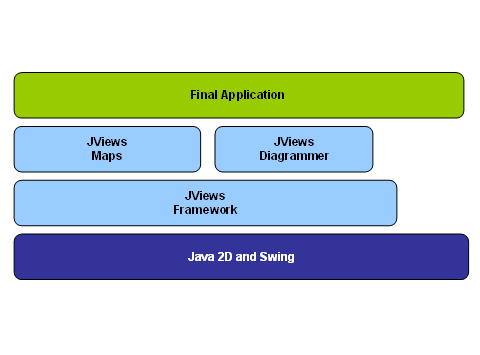You may have specific requirements in your
application that cannot be satisfied by the pre-defined behavior of
the Map Builder or the Designer alone. For example, if your
application requires specialized interactions or if you need to
implement the data model interface to connect to your application
data.
The SDK offers you a comprehensive API to use or extend the Java™ classes involved in the creation
of your map-based application. You can basically access all the
entities involved in your application, enrich them with new
behavior, or modify predefined behavior. See the Programmer's
documentation for more detailed information.

SDK layers in JViews
Maps
All JViews libraries are built on top of the Java 2D™ and Swing libraries, with no
platform-specific code. This means that applications developed
with JViews Maps run
on any platform that supports Java™
.
On top of this low-level layer is the JViews Framework layer,
which includes among others efficient data structures, prebuilt
user interaction services, and a printing facility.
Above JViews Framework
is Rogue Wave® JViews
Maps, which provides a wide range of map manipulation and display
services. It is built on the data structures and I/O facilities of
JViews Framework.
At the same level, there is JViews
Diagrammer, which provides a wide variety of displays consisting
of custom graphic objects that are data-aware. This means that the
graphic objects in the display can change their appearance as the
underlying data model changes. For example, a graphic object that
represents a vehicle can have its color change if its status field
changes.
The JViews Diagrammer
SDK is needed when you display interactive objects on top of your
maps (the symbols), whereas the Rogue Wave® JViews Maps SDK handles the
background map manipulations.
Rogue Wave® JViews
Diagrammer uses a Model-View-Controller (MVC) architecture that
will be very familiar to Java™
programmers used to the Swing structure. Its purpose is to separate
the data model from the views and connect the two with a rule-based
style manager that controls the look of the objects based on the
data values.
JViews Diagrammer calls
this mechanism Styling and Data Mapping (SDM). It is used by JViews Maps to store and
manipulate any interactive object that appears on top of a map.
Thus, JViews Maps
uses two distinct data structures:
- One for storing the map data that is relatively static (such as definitions for roads and boundaries).
- SDM for storing information about the custom objects of an application.